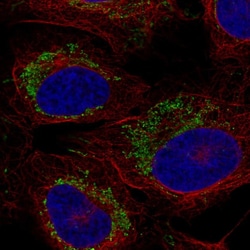Promotional price valid on web orders only. Your contract pricing may differ. Interested in signing up for a dedicated account number?
Learn More
Learn More
Invitrogen™ CCR7 Polyclonal Antibody
Rabbit Polyclonal Antibody
$589.50
Specifications
| Antigen | CCR7 |
|---|---|
| Content And Storage | Store at 4°C short term. For long term storage, store at -20°C, avoiding freeze/thaw cycles. |
| Applications | Immunocytochemistry |
| Classification | Polyclonal |
| Conjugate | Unconjugated |
| Catalog Number | Mfr. No. | Immunogen | Price | Quantity & Availability | |||||
|---|---|---|---|---|---|---|---|---|---|
| Catalog Number | Mfr. No. | Immunogen | Price | Quantity & Availability | |||||
|
PIPA5111020
|
Invitrogen™
PA5111020 |
Recombinant Protein corresonding to Human CCR7. Recombinant protein control fragment (Product #RP-105854)., GVKFRNDLFK LFKDLGCLSQ EQLRQWSSCR HIRRSSMSVE AETTTTFS |
Each for $589.50
|
|
|||||
|
PIPA5111719
|
Invitrogen™
PA5111719 |
Recombinant Protein corresonding to Human CCR7. Recombinant protein control fragment (Product #RP-108001)., QDEVTDDYIG DNTTVDYTLF ESLCSKKDVR NFKA |
Each for $589.50
|
|
|||||
Description
CCR7 is a member of the G protein coupled receptor family, which is a subfamily of chemokines. CCR7 was identified to be induced by the Epstein Barr virus (EBV), and is thought to be a mediator of EBV effects on B lymphocytes. CCR7 has been reported to be expressed in blood, bone marrow, lymph node, and intestine. CCR7 is particularly expressed in lymphoid tissues and in activated B and T lymphocytes and has been shown to control the migration of memory T cells to inflamed tissues, as well as stimulate dendritic cell maturation. The chemokine (C-C motif) ligand 19 (CCL19/ECL) has been reported to be a specific ligand of this receptor. ESTs have been isolated from blood, embryo, lymph node, and thymus libraries. Receptors for the C - C chemokine family include CCR 1, CCR 2A, CCR 3, CCR 4, CCR 5 and the Duffy blood group antigen. The C-C receptors are important in the function of T cell chemotaxis and migration of phagocytic cells to sites of inflammation.Specifications
| CCR7 | |
| Immunocytochemistry | |
| Unconjugated | |
| Rabbit | |
| RUO | |
| PBS with 40% glycerol and 0.02% sodium azide; pH 7.2 | |
| P32248 | |
| 1236 | |
| Primary | |
| Antigen affinity chromatography |
| Store at 4°C short term. For long term storage, store at -20°C, avoiding freeze/thaw cycles. | |
| Polyclonal | |
| Liquid | |
| IgG | |
| Human | |
| Ccr7 | |
| BLR2; Bukitt's lymphoma receptor 2; CC chemokine receptor 7; C-C chemokine receptor type 7; C-C CKR-7; C-C motif chemokine receptor 7; CC-CKR-7; CCR7; CCR-7; CD197; CDw197; chemokine (C-C motif) receptor 7; chemokine (C-C) receptor 7; Cmkbr7; EBI1; Ebi1h; EBV-induced G protein-coupled receptor 1; EBV-induced G-protein coupled receptor 1; Epstein-Barr virus induced gene 1; Epstein-Barr virus-induced G-protein coupled receptor 1; EVI1; lymphocyte-specific G protein-coupled peptide receptor; MIP-3 beta receptor | |
| Ccr7 | |
| Antibody |
Spot an opportunity for improvement?Share a Content Correction
Product Content Correction
Your input is important to us. Please complete this form to provide feedback related to the content on this product.
Product Title

